Analysis of Motivational Theories in Starbucks' Leadership
VerifiedAdded on 2021/04/17
|9
|2353
|206
Essay
AI Summary
This essay provides an analysis of motivational theories and their application in the context of Starbucks, specifically focusing on the leadership of Howard Schultz. It explores three key motivational theories: Maslow's hierarchy of needs, Herzberg's two-factor theory, and Adam's equity theory. The essay examines how Schultz utilized these theories to motivate employees, improve their work environment, and increase overall organizational performance. It details the practical implementation of each theory within Starbucks, including providing a good work environment, offering benefits, and treating employees as partners. The essay also discusses the managerial implications of these theories, emphasizing their importance in fulfilling employee needs, addressing job satisfaction and dissatisfaction factors, and ensuring fair treatment and compensation. The conclusion highlights the positive impact of these motivational strategies on employee productivity and organizational revenue.

Running head: ANALYSIS OF MOTIVATIONAL THEORIES
ANALYSIS OF MOTIVATIONAL THEORIES
Name of the Student
Name of the University
Author Note
ANALYSIS OF MOTIVATIONAL THEORIES
Name of the Student
Name of the University
Author Note
Paraphrase This Document
Need a fresh take? Get an instant paraphrase of this document with our AI Paraphraser

ANALYSIS OF MOTIVATIONAL THEORIES
1
Introduction
Starbucks is a multinational coffeehouse chain of American origin and the
organization has its headquarters in Seattle Washington. The organization has its operations
in more than 27,000 locations all over the world and is considered the major representative of
“second wave coffee” which differentiates itself from the other coffeehouse chains in the
world. Starbucks has held the position of the world’s largest coffeehouse chain for many
years now. The products of the organization are considered to be unique as compared to the
coffee products offered by the organizations in the industry (Starbucks Coffee Company.
2018).
The essay will be based on the analysis of the ways by which the three different
motivational theories were used by Howards Schultz, the former CEO of the organization to
motivate the employees. The motivational theories will also be analysed based on their usage
by Schultz in Starbucks for the purpose providing motivation to the employees.
Analysis of the three motivational theories based on their usage in Starbucks
Maslow’s theory of motivation in Starbucks
Motivation is a psychological process and is important for the purpose of increasing
the efficiency of the employees and putting them in a position where they can gain from the
operations in the organization. The compensation provided to the employees is not always
enough to motivate them in work. Starbucks has therefore developed different ways to keep
the employees happy and increase their revenues by depending on them. The motivation
process that was used by the former CEO of the organization Howard Schultz can be defined
based on the Maslow’s theory of motivation (Mokhtarian, Salomon and Singer 2015).
According to Schultz, the motivated employees give much more importance to their work and
1
Introduction
Starbucks is a multinational coffeehouse chain of American origin and the
organization has its headquarters in Seattle Washington. The organization has its operations
in more than 27,000 locations all over the world and is considered the major representative of
“second wave coffee” which differentiates itself from the other coffeehouse chains in the
world. Starbucks has held the position of the world’s largest coffeehouse chain for many
years now. The products of the organization are considered to be unique as compared to the
coffee products offered by the organizations in the industry (Starbucks Coffee Company.
2018).
The essay will be based on the analysis of the ways by which the three different
motivational theories were used by Howards Schultz, the former CEO of the organization to
motivate the employees. The motivational theories will also be analysed based on their usage
by Schultz in Starbucks for the purpose providing motivation to the employees.
Analysis of the three motivational theories based on their usage in Starbucks
Maslow’s theory of motivation in Starbucks
Motivation is a psychological process and is important for the purpose of increasing
the efficiency of the employees and putting them in a position where they can gain from the
operations in the organization. The compensation provided to the employees is not always
enough to motivate them in work. Starbucks has therefore developed different ways to keep
the employees happy and increase their revenues by depending on them. The motivation
process that was used by the former CEO of the organization Howard Schultz can be defined
based on the Maslow’s theory of motivation (Mokhtarian, Salomon and Singer 2015).
According to Schultz, the motivated employees give much more importance to their work and

ANALYSIS OF MOTIVATIONAL THEORIES
2
are willing to provide the services that are expected from them. The motivated and happy
employees can easily satisfy the customers of the organization which is the main concern of
the management. The Maslow’s motivational theory was used by Schultz in the following
way,
The theory of Maslow is mainly based on the needs of the employees and their levels
of trust on the organization. The five needs as discussed by Maslow are, physiological needs,
safety needs, social needs, self-esteem needs and self-actualization needs (Viksne, Bormane
and Feng 2017).
Physiological needs are related to the fulfilments of the basic demands of the
employees which include good work environment, regular wages and other basic needs of
their daily lives. Schultz has always given emphasis on providing the employees with an
environment where they can work in an active manner.
Safety needs are related to the protection and security that is provided by Schultz to
the staff. The organization has provided pension strategy for the staff and security related to
their safety and health (Singh and Behera 2016).
Social needs of the staff have been fulfilled by making them work like a team and
give them competitive wages. Schultz has made sure that positive work environment is
provided to the part-time and the full-time employees as well.
The protection of the self-esteem of the staff has been ensured by Schultz by creating
an environment of respect in the organization where the employees give regard to each other
irrespective of their positions in the hierarchy.
2
are willing to provide the services that are expected from them. The motivated and happy
employees can easily satisfy the customers of the organization which is the main concern of
the management. The Maslow’s motivational theory was used by Schultz in the following
way,
The theory of Maslow is mainly based on the needs of the employees and their levels
of trust on the organization. The five needs as discussed by Maslow are, physiological needs,
safety needs, social needs, self-esteem needs and self-actualization needs (Viksne, Bormane
and Feng 2017).
Physiological needs are related to the fulfilments of the basic demands of the
employees which include good work environment, regular wages and other basic needs of
their daily lives. Schultz has always given emphasis on providing the employees with an
environment where they can work in an active manner.
Safety needs are related to the protection and security that is provided by Schultz to
the staff. The organization has provided pension strategy for the staff and security related to
their safety and health (Singh and Behera 2016).
Social needs of the staff have been fulfilled by making them work like a team and
give them competitive wages. Schultz has made sure that positive work environment is
provided to the part-time and the full-time employees as well.
The protection of the self-esteem of the staff has been ensured by Schultz by creating
an environment of respect in the organization where the employees give regard to each other
irrespective of their positions in the hierarchy.
⊘ This is a preview!⊘
Do you want full access?
Subscribe today to unlock all pages.

Trusted by 1+ million students worldwide
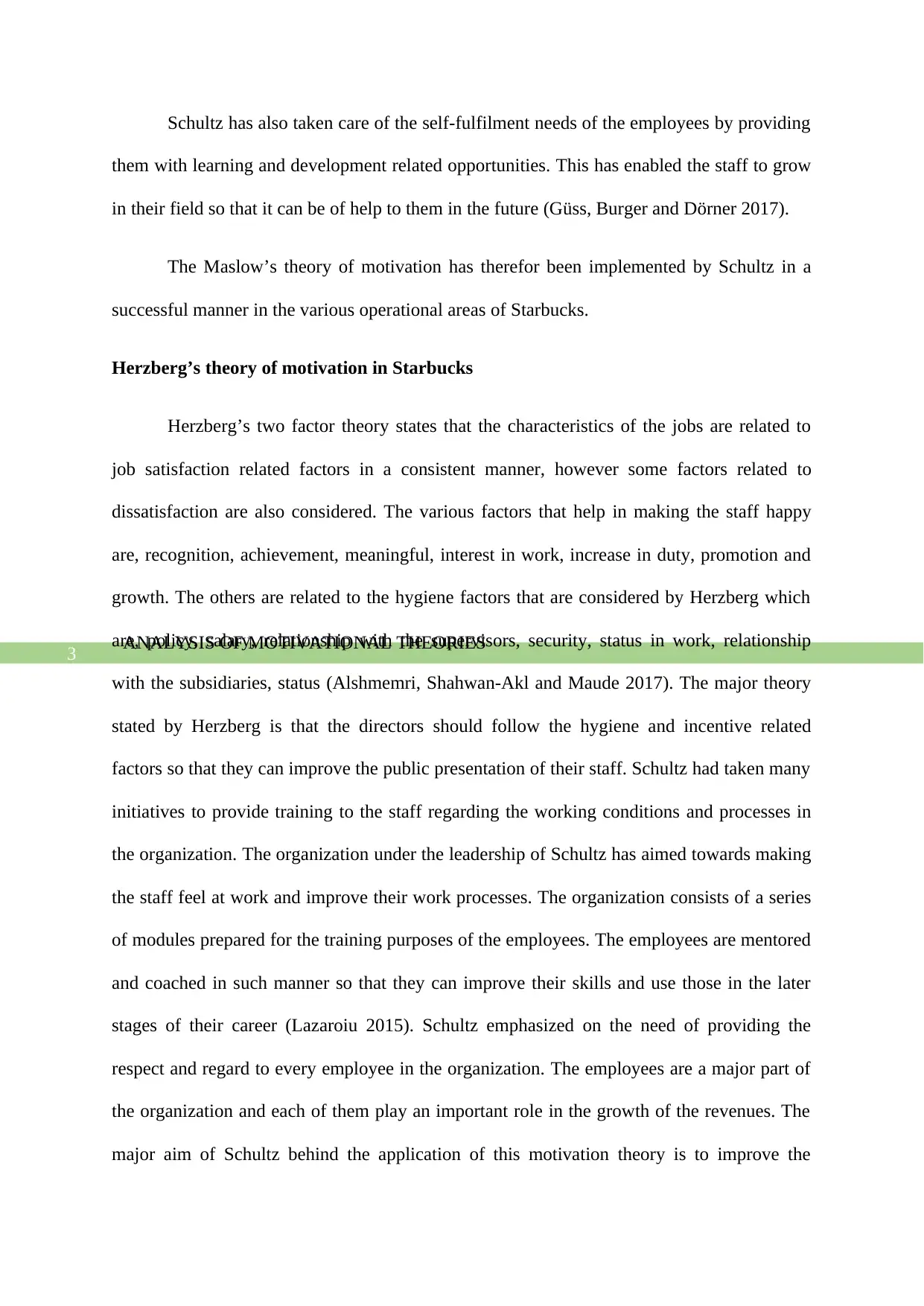
ANALYSIS OF MOTIVATIONAL THEORIES
3
Schultz has also taken care of the self-fulfilment needs of the employees by providing
them with learning and development related opportunities. This has enabled the staff to grow
in their field so that it can be of help to them in the future (Güss, Burger and Dörner 2017).
The Maslow’s theory of motivation has therefor been implemented by Schultz in a
successful manner in the various operational areas of Starbucks.
Herzberg’s theory of motivation in Starbucks
Herzberg’s two factor theory states that the characteristics of the jobs are related to
job satisfaction related factors in a consistent manner, however some factors related to
dissatisfaction are also considered. The various factors that help in making the staff happy
are, recognition, achievement, meaningful, interest in work, increase in duty, promotion and
growth. The others are related to the hygiene factors that are considered by Herzberg which
are, policy, salary, relationship with the supervisors, security, status in work, relationship
with the subsidiaries, status (Alshmemri, Shahwan-Akl and Maude 2017). The major theory
stated by Herzberg is that the directors should follow the hygiene and incentive related
factors so that they can improve the public presentation of their staff. Schultz had taken many
initiatives to provide training to the staff regarding the working conditions and processes in
the organization. The organization under the leadership of Schultz has aimed towards making
the staff feel at work and improve their work processes. The organization consists of a series
of modules prepared for the training purposes of the employees. The employees are mentored
and coached in such manner so that they can improve their skills and use those in the later
stages of their career (Lazaroiu 2015). Schultz emphasized on the need of providing the
respect and regard to every employee in the organization. The employees are a major part of
the organization and each of them play an important role in the growth of the revenues. The
major aim of Schultz behind the application of this motivation theory is to improve the
3
Schultz has also taken care of the self-fulfilment needs of the employees by providing
them with learning and development related opportunities. This has enabled the staff to grow
in their field so that it can be of help to them in the future (Güss, Burger and Dörner 2017).
The Maslow’s theory of motivation has therefor been implemented by Schultz in a
successful manner in the various operational areas of Starbucks.
Herzberg’s theory of motivation in Starbucks
Herzberg’s two factor theory states that the characteristics of the jobs are related to
job satisfaction related factors in a consistent manner, however some factors related to
dissatisfaction are also considered. The various factors that help in making the staff happy
are, recognition, achievement, meaningful, interest in work, increase in duty, promotion and
growth. The others are related to the hygiene factors that are considered by Herzberg which
are, policy, salary, relationship with the supervisors, security, status in work, relationship
with the subsidiaries, status (Alshmemri, Shahwan-Akl and Maude 2017). The major theory
stated by Herzberg is that the directors should follow the hygiene and incentive related
factors so that they can improve the public presentation of their staff. Schultz had taken many
initiatives to provide training to the staff regarding the working conditions and processes in
the organization. The organization under the leadership of Schultz has aimed towards making
the staff feel at work and improve their work processes. The organization consists of a series
of modules prepared for the training purposes of the employees. The employees are mentored
and coached in such manner so that they can improve their skills and use those in the later
stages of their career (Lazaroiu 2015). Schultz emphasized on the need of providing the
respect and regard to every employee in the organization. The employees are a major part of
the organization and each of them play an important role in the growth of the revenues. The
major aim of Schultz behind the application of this motivation theory is to improve the
Paraphrase This Document
Need a fresh take? Get an instant paraphrase of this document with our AI Paraphraser
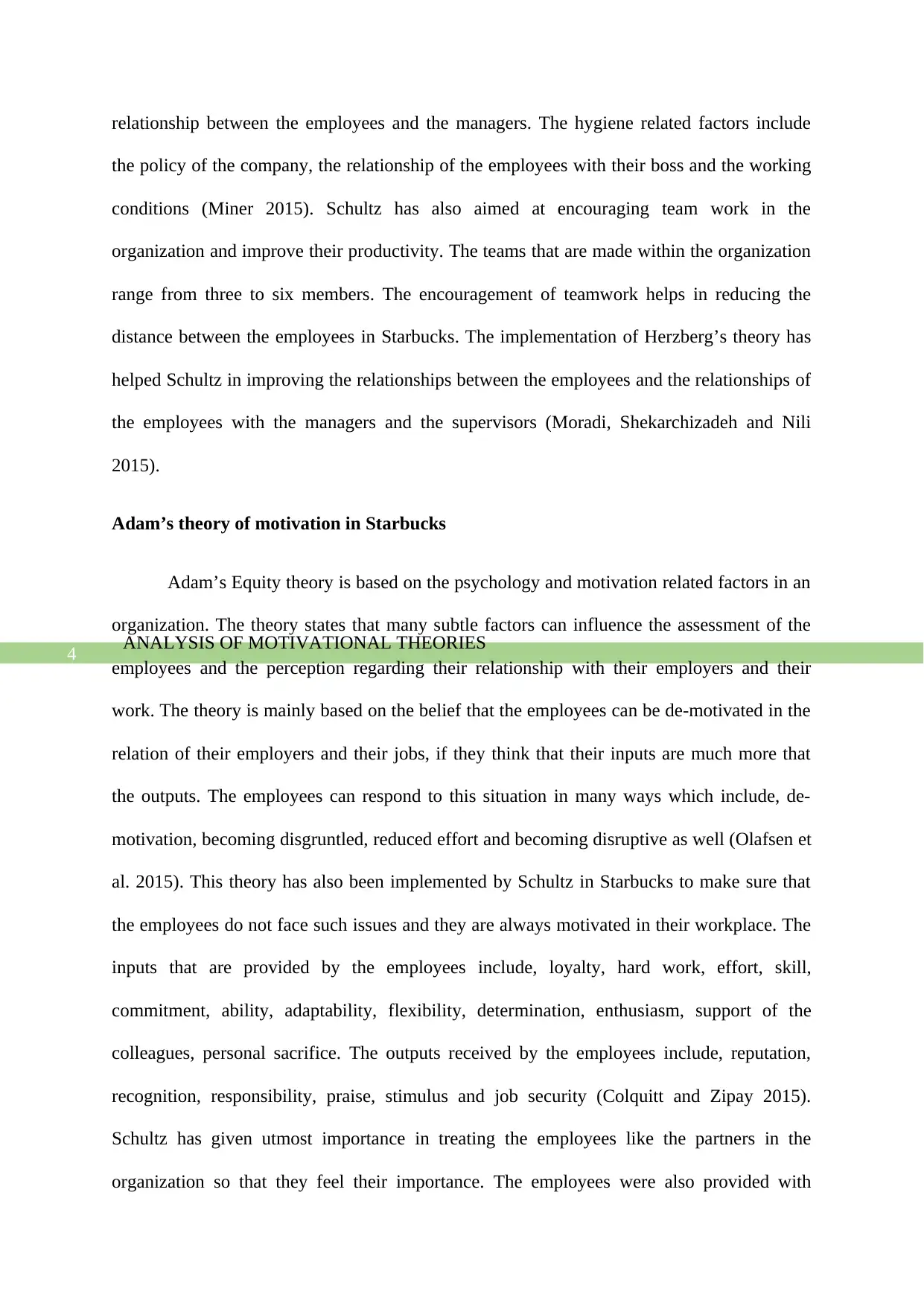
ANALYSIS OF MOTIVATIONAL THEORIES
4
relationship between the employees and the managers. The hygiene related factors include
the policy of the company, the relationship of the employees with their boss and the working
conditions (Miner 2015). Schultz has also aimed at encouraging team work in the
organization and improve their productivity. The teams that are made within the organization
range from three to six members. The encouragement of teamwork helps in reducing the
distance between the employees in Starbucks. The implementation of Herzberg’s theory has
helped Schultz in improving the relationships between the employees and the relationships of
the employees with the managers and the supervisors (Moradi, Shekarchizadeh and Nili
2015).
Adam’s theory of motivation in Starbucks
Adam’s Equity theory is based on the psychology and motivation related factors in an
organization. The theory states that many subtle factors can influence the assessment of the
employees and the perception regarding their relationship with their employers and their
work. The theory is mainly based on the belief that the employees can be de-motivated in the
relation of their employers and their jobs, if they think that their inputs are much more that
the outputs. The employees can respond to this situation in many ways which include, de-
motivation, becoming disgruntled, reduced effort and becoming disruptive as well (Olafsen et
al. 2015). This theory has also been implemented by Schultz in Starbucks to make sure that
the employees do not face such issues and they are always motivated in their workplace. The
inputs that are provided by the employees include, loyalty, hard work, effort, skill,
commitment, ability, adaptability, flexibility, determination, enthusiasm, support of the
colleagues, personal sacrifice. The outputs received by the employees include, reputation,
recognition, responsibility, praise, stimulus and job security (Colquitt and Zipay 2015).
Schultz has given utmost importance in treating the employees like the partners in the
organization so that they feel their importance. The employees were also provided with
4
relationship between the employees and the managers. The hygiene related factors include
the policy of the company, the relationship of the employees with their boss and the working
conditions (Miner 2015). Schultz has also aimed at encouraging team work in the
organization and improve their productivity. The teams that are made within the organization
range from three to six members. The encouragement of teamwork helps in reducing the
distance between the employees in Starbucks. The implementation of Herzberg’s theory has
helped Schultz in improving the relationships between the employees and the relationships of
the employees with the managers and the supervisors (Moradi, Shekarchizadeh and Nili
2015).
Adam’s theory of motivation in Starbucks
Adam’s Equity theory is based on the psychology and motivation related factors in an
organization. The theory states that many subtle factors can influence the assessment of the
employees and the perception regarding their relationship with their employers and their
work. The theory is mainly based on the belief that the employees can be de-motivated in the
relation of their employers and their jobs, if they think that their inputs are much more that
the outputs. The employees can respond to this situation in many ways which include, de-
motivation, becoming disgruntled, reduced effort and becoming disruptive as well (Olafsen et
al. 2015). This theory has also been implemented by Schultz in Starbucks to make sure that
the employees do not face such issues and they are always motivated in their workplace. The
inputs that are provided by the employees include, loyalty, hard work, effort, skill,
commitment, ability, adaptability, flexibility, determination, enthusiasm, support of the
colleagues, personal sacrifice. The outputs received by the employees include, reputation,
recognition, responsibility, praise, stimulus and job security (Colquitt and Zipay 2015).
Schultz has given utmost importance in treating the employees like the partners in the
organization so that they feel their importance. The employees were also provided with
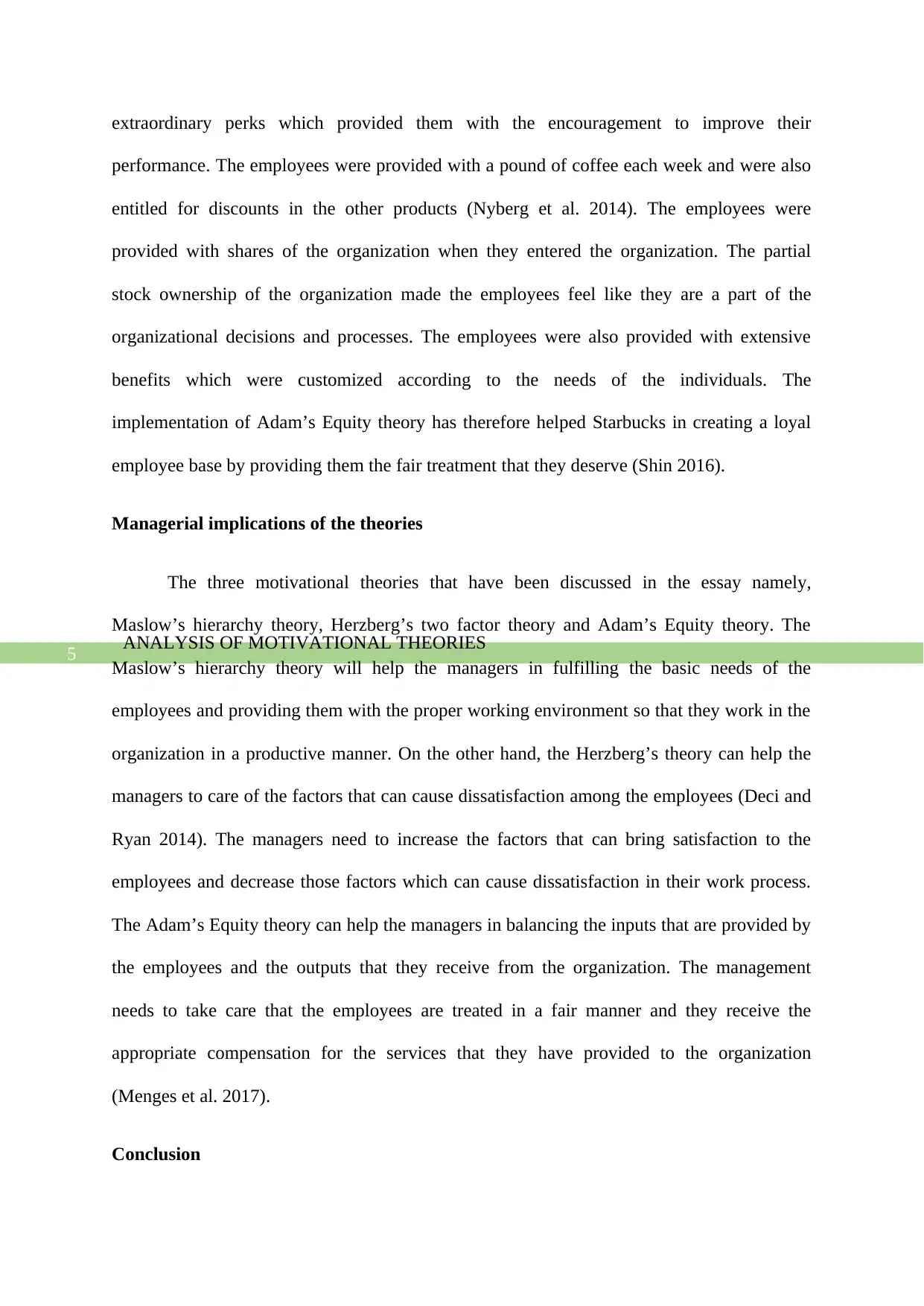
ANALYSIS OF MOTIVATIONAL THEORIES
5
extraordinary perks which provided them with the encouragement to improve their
performance. The employees were provided with a pound of coffee each week and were also
entitled for discounts in the other products (Nyberg et al. 2014). The employees were
provided with shares of the organization when they entered the organization. The partial
stock ownership of the organization made the employees feel like they are a part of the
organizational decisions and processes. The employees were also provided with extensive
benefits which were customized according to the needs of the individuals. The
implementation of Adam’s Equity theory has therefore helped Starbucks in creating a loyal
employee base by providing them the fair treatment that they deserve (Shin 2016).
Managerial implications of the theories
The three motivational theories that have been discussed in the essay namely,
Maslow’s hierarchy theory, Herzberg’s two factor theory and Adam’s Equity theory. The
Maslow’s hierarchy theory will help the managers in fulfilling the basic needs of the
employees and providing them with the proper working environment so that they work in the
organization in a productive manner. On the other hand, the Herzberg’s theory can help the
managers to care of the factors that can cause dissatisfaction among the employees (Deci and
Ryan 2014). The managers need to increase the factors that can bring satisfaction to the
employees and decrease those factors which can cause dissatisfaction in their work process.
The Adam’s Equity theory can help the managers in balancing the inputs that are provided by
the employees and the outputs that they receive from the organization. The management
needs to take care that the employees are treated in a fair manner and they receive the
appropriate compensation for the services that they have provided to the organization
(Menges et al. 2017).
Conclusion
5
extraordinary perks which provided them with the encouragement to improve their
performance. The employees were provided with a pound of coffee each week and were also
entitled for discounts in the other products (Nyberg et al. 2014). The employees were
provided with shares of the organization when they entered the organization. The partial
stock ownership of the organization made the employees feel like they are a part of the
organizational decisions and processes. The employees were also provided with extensive
benefits which were customized according to the needs of the individuals. The
implementation of Adam’s Equity theory has therefore helped Starbucks in creating a loyal
employee base by providing them the fair treatment that they deserve (Shin 2016).
Managerial implications of the theories
The three motivational theories that have been discussed in the essay namely,
Maslow’s hierarchy theory, Herzberg’s two factor theory and Adam’s Equity theory. The
Maslow’s hierarchy theory will help the managers in fulfilling the basic needs of the
employees and providing them with the proper working environment so that they work in the
organization in a productive manner. On the other hand, the Herzberg’s theory can help the
managers to care of the factors that can cause dissatisfaction among the employees (Deci and
Ryan 2014). The managers need to increase the factors that can bring satisfaction to the
employees and decrease those factors which can cause dissatisfaction in their work process.
The Adam’s Equity theory can help the managers in balancing the inputs that are provided by
the employees and the outputs that they receive from the organization. The management
needs to take care that the employees are treated in a fair manner and they receive the
appropriate compensation for the services that they have provided to the organization
(Menges et al. 2017).
Conclusion
⊘ This is a preview!⊘
Do you want full access?
Subscribe today to unlock all pages.

Trusted by 1+ million students worldwide
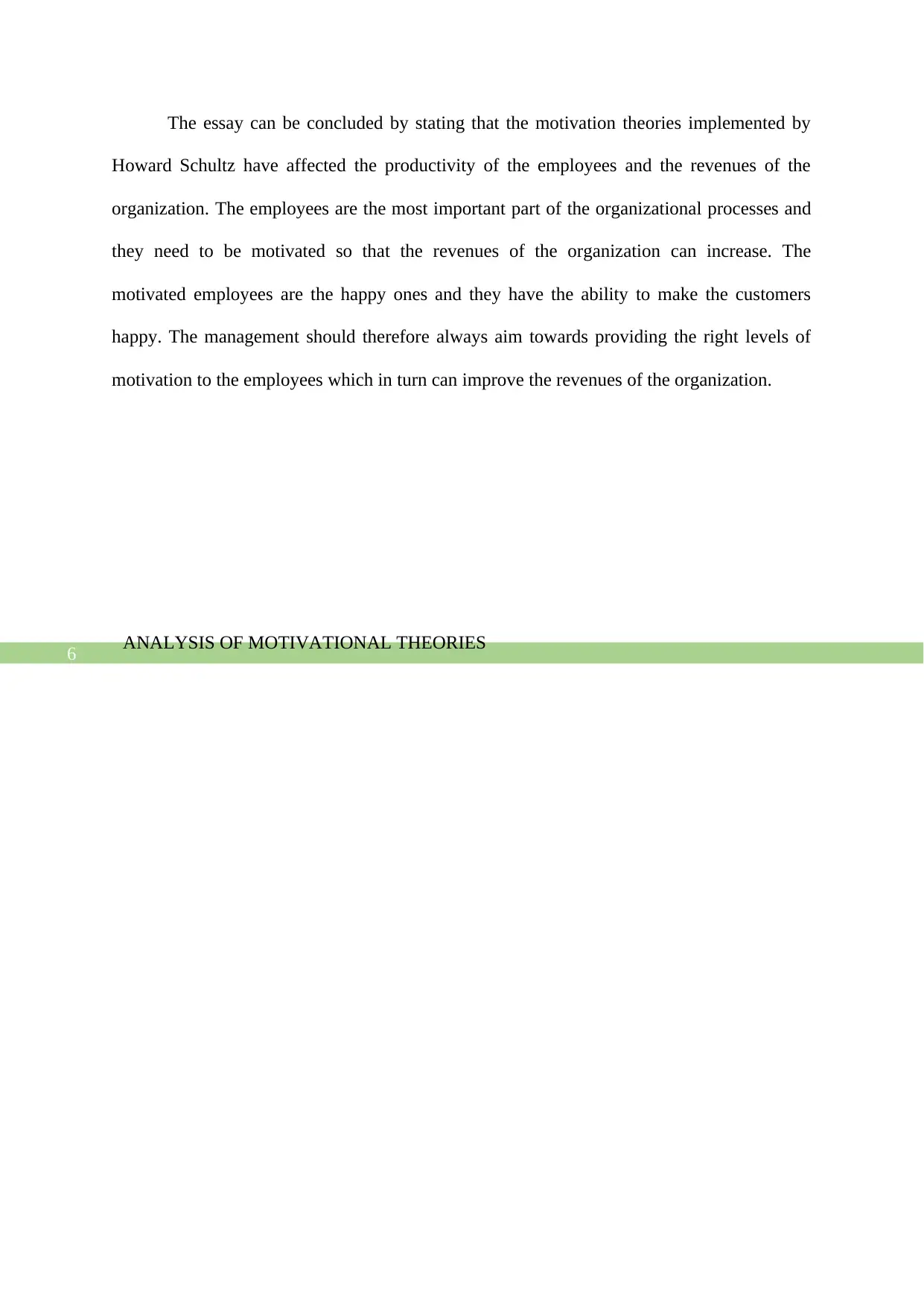
ANALYSIS OF MOTIVATIONAL THEORIES
6
The essay can be concluded by stating that the motivation theories implemented by
Howard Schultz have affected the productivity of the employees and the revenues of the
organization. The employees are the most important part of the organizational processes and
they need to be motivated so that the revenues of the organization can increase. The
motivated employees are the happy ones and they have the ability to make the customers
happy. The management should therefore always aim towards providing the right levels of
motivation to the employees which in turn can improve the revenues of the organization.
6
The essay can be concluded by stating that the motivation theories implemented by
Howard Schultz have affected the productivity of the employees and the revenues of the
organization. The employees are the most important part of the organizational processes and
they need to be motivated so that the revenues of the organization can increase. The
motivated employees are the happy ones and they have the ability to make the customers
happy. The management should therefore always aim towards providing the right levels of
motivation to the employees which in turn can improve the revenues of the organization.
Paraphrase This Document
Need a fresh take? Get an instant paraphrase of this document with our AI Paraphraser

ANALYSIS OF MOTIVATIONAL THEORIES
7
References
Alshmemri, M., Shahwan-Akl, L. and Maude, P., 2017. Herzberg’s two-factor theory. Life
Science Journal, 14(5).
Colquitt, J.A. and Zipay, K.P., 2015. Justice, fairness, and employee reactions. Annu. Rev.
Organ. Psychol. Organ. Behav., 2(1), pp.75-99.
Deci, E.L. and Ryan, R.M., 2014. The importance of universal psychological needs for
understanding motivation in the workplace. The Oxford handbook of work engagement,
motivation, and self-determination theory, pp.13-32.
Güss, C.D., Burger, M.L. and Dörner, D., 2017. The Role of Motivation in Complex Problem
Solving. Frontiers in psychology, 8, p.851.
Lazaroiu, G., 2015. Work motivation and organizational behavior. Contemporary Readings
in Law and Social Justice, 7(2), p.66.
Menges, J.I., Tussing, D.V., Wihler, A. and Grant, A.M., 2017. When job performance is all
relative: how family motivation energizes effort and compensates for intrinsic
motivation. Academy of Management Journal, 60(2), pp.695-719.
Miner, J.B., 2015. Motivation-Hygiene Theory: Frederick Herzberg. In Organizational
Behavior 1 (pp. 77-90). Routledge.
Mokhtarian, P.L., Salomon, I. and Singer, M.E., 2015. What moves us? An interdisciplinary
exploration of reasons for traveling. Transport reviews, 35(3), pp.250-274.
Moradi, M., Shekarchizadeh, A.R. and Nili, M., 2015. Determination of Factors that
Affecting on Motivation and Assessing their Impact on Employee Performance. Research
Journal of Recent Sciences ISSN, 2277, p.2502.
7
References
Alshmemri, M., Shahwan-Akl, L. and Maude, P., 2017. Herzberg’s two-factor theory. Life
Science Journal, 14(5).
Colquitt, J.A. and Zipay, K.P., 2015. Justice, fairness, and employee reactions. Annu. Rev.
Organ. Psychol. Organ. Behav., 2(1), pp.75-99.
Deci, E.L. and Ryan, R.M., 2014. The importance of universal psychological needs for
understanding motivation in the workplace. The Oxford handbook of work engagement,
motivation, and self-determination theory, pp.13-32.
Güss, C.D., Burger, M.L. and Dörner, D., 2017. The Role of Motivation in Complex Problem
Solving. Frontiers in psychology, 8, p.851.
Lazaroiu, G., 2015. Work motivation and organizational behavior. Contemporary Readings
in Law and Social Justice, 7(2), p.66.
Menges, J.I., Tussing, D.V., Wihler, A. and Grant, A.M., 2017. When job performance is all
relative: how family motivation energizes effort and compensates for intrinsic
motivation. Academy of Management Journal, 60(2), pp.695-719.
Miner, J.B., 2015. Motivation-Hygiene Theory: Frederick Herzberg. In Organizational
Behavior 1 (pp. 77-90). Routledge.
Mokhtarian, P.L., Salomon, I. and Singer, M.E., 2015. What moves us? An interdisciplinary
exploration of reasons for traveling. Transport reviews, 35(3), pp.250-274.
Moradi, M., Shekarchizadeh, A.R. and Nili, M., 2015. Determination of Factors that
Affecting on Motivation and Assessing their Impact on Employee Performance. Research
Journal of Recent Sciences ISSN, 2277, p.2502.
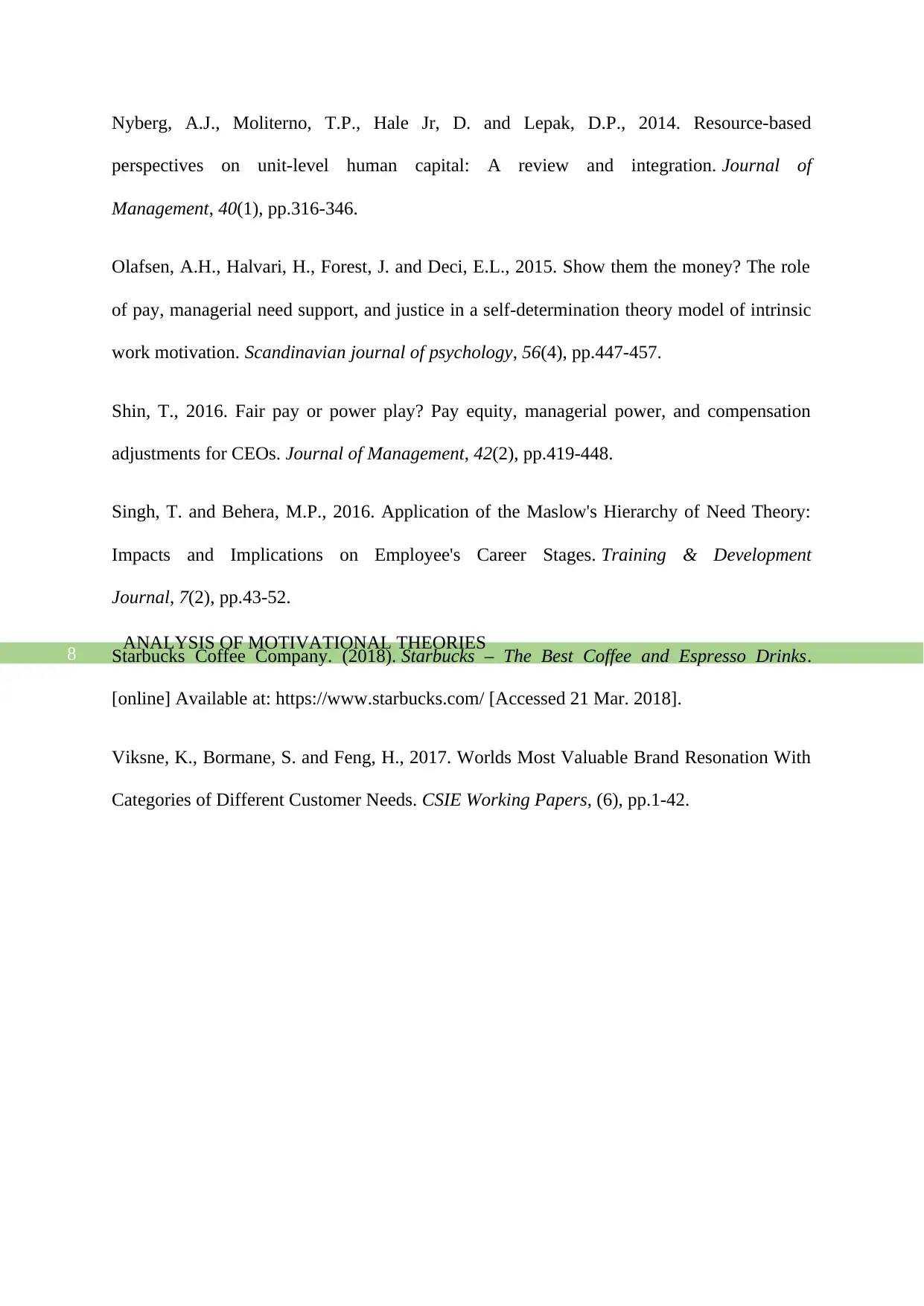
ANALYSIS OF MOTIVATIONAL THEORIES
8
Nyberg, A.J., Moliterno, T.P., Hale Jr, D. and Lepak, D.P., 2014. Resource-based
perspectives on unit-level human capital: A review and integration. Journal of
Management, 40(1), pp.316-346.
Olafsen, A.H., Halvari, H., Forest, J. and Deci, E.L., 2015. Show them the money? The role
of pay, managerial need support, and justice in a self‐determination theory model of intrinsic
work motivation. Scandinavian journal of psychology, 56(4), pp.447-457.
Shin, T., 2016. Fair pay or power play? Pay equity, managerial power, and compensation
adjustments for CEOs. Journal of Management, 42(2), pp.419-448.
Singh, T. and Behera, M.P., 2016. Application of the Maslow's Hierarchy of Need Theory:
Impacts and Implications on Employee's Career Stages. Training & Development
Journal, 7(2), pp.43-52.
Starbucks Coffee Company. (2018). Starbucks – The Best Coffee and Espresso Drinks.
[online] Available at: https://www.starbucks.com/ [Accessed 21 Mar. 2018].
Viksne, K., Bormane, S. and Feng, H., 2017. Worlds Most Valuable Brand Resonation With
Categories of Different Customer Needs. CSIE Working Papers, (6), pp.1-42.
8
Nyberg, A.J., Moliterno, T.P., Hale Jr, D. and Lepak, D.P., 2014. Resource-based
perspectives on unit-level human capital: A review and integration. Journal of
Management, 40(1), pp.316-346.
Olafsen, A.H., Halvari, H., Forest, J. and Deci, E.L., 2015. Show them the money? The role
of pay, managerial need support, and justice in a self‐determination theory model of intrinsic
work motivation. Scandinavian journal of psychology, 56(4), pp.447-457.
Shin, T., 2016. Fair pay or power play? Pay equity, managerial power, and compensation
adjustments for CEOs. Journal of Management, 42(2), pp.419-448.
Singh, T. and Behera, M.P., 2016. Application of the Maslow's Hierarchy of Need Theory:
Impacts and Implications on Employee's Career Stages. Training & Development
Journal, 7(2), pp.43-52.
Starbucks Coffee Company. (2018). Starbucks – The Best Coffee and Espresso Drinks.
[online] Available at: https://www.starbucks.com/ [Accessed 21 Mar. 2018].
Viksne, K., Bormane, S. and Feng, H., 2017. Worlds Most Valuable Brand Resonation With
Categories of Different Customer Needs. CSIE Working Papers, (6), pp.1-42.
⊘ This is a preview!⊘
Do you want full access?
Subscribe today to unlock all pages.

Trusted by 1+ million students worldwide
1 out of 9
Related Documents
Your All-in-One AI-Powered Toolkit for Academic Success.
+13062052269
info@desklib.com
Available 24*7 on WhatsApp / Email
![[object Object]](/_next/static/media/star-bottom.7253800d.svg)
Unlock your academic potential
Copyright © 2020–2025 A2Z Services. All Rights Reserved. Developed and managed by ZUCOL.





